This was published 4 years ago
From ‘the flatlands’ of Berkeley to the White House: The rise of Kamala Harris
This profile of Kamala Harris and her journey to US vice-president was first published in February 2021. We’re resurfacing the article after Joe Biden resigned as the Democratic presidential nominee, backing Harris as successor.
By Nick Bryant
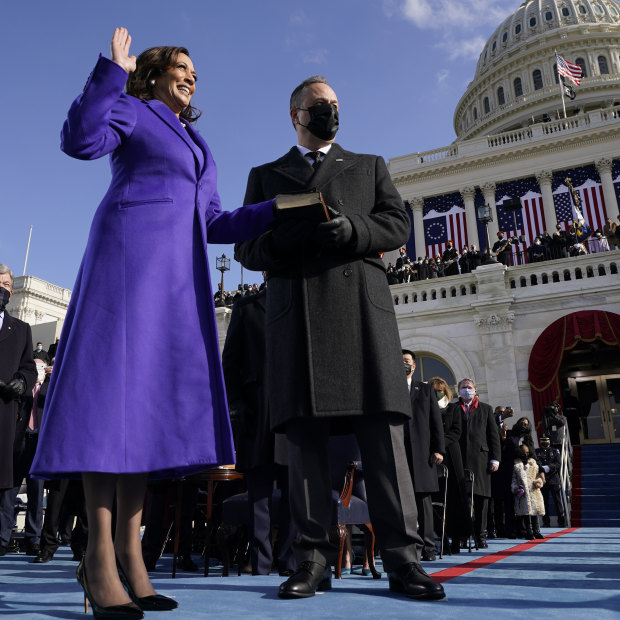
Kamala Harris takes the oath of office on January 20 with her husband, Doug Emhoff, by her side.Credit: Andrew Harnik – Pool/Getty Images
Out she steps in suffragette white, the radiance of her pantsuit giving her an almost celestial air – as if she is the gatekeeper to some other world. COVID-19 has turned this into a drive-in victory party, so supporters are honking their horns, cheering muffled cheers out of the half-open windows of their SUVs, and waving American flags from the cargo beds of their pick-up trucks.
For the revellers granted entry into this parking lot in Wilmington, Delaware, hours after the US networks have finally called the presidential election, this is a triple celebration. There is home-town pride in the victory of Joe Biden. There is relief that the presidency of Donald Trump will soon be viewed in the rear-view mirror. And there is wonder as the US marks another milestone in its 244-year journey. Kamala Harris will not only become the first black and Indian-American to serve as vice-president, but also the first woman.
Next to me are two elderly African-American women, the Democratic Party’s most loyal constituency. They are peering skyward and mouthing prayers of thanks. Kamala Harris’ presence on stage, they may be thinking, offers reassurance that black lives matter. Just a few metres in front of us, the 56-year-old senator is savouring her moment in history’s spotlight.
She comes to the front of the platform, the black mask she arrived wearing now removed, and beams at this vehicular mosh pit. Her smile, if anything, is more glowing than her suit. Then, from behind bulletproof sheets of glass, she launches into her prepared text, and delivers the sound bite that will instantly go viral. “While I may be the first woman in this office,” she says of becoming Vice-President-elect. “I won’t be the last.”
Kamala Harris has been elected to a job that has long been the butt of jibes and punch lines, many of them uttered by the 48 men who have served as vice-president.
The New York billionaire Nelson Rockefeller, who was Gerald Ford’s deputy, complained that his main responsibilities were attending earthquakes and funerals. FDR’s VP John Nance Garner memorably observed the job was “not worth a bucket of warm spit”. John Adams, the new republic’s first VP, described it as “the most insignificant office that ever the invention of man contrived”. Yet Adams was also wily enough to understand the opportunity it presented for rapid career advancement: “In this I am nothing. But I may be everything.”
That observation is especially germane for Kamala Harris. The deputy to Joe Biden, who at 78 is the oldest man to occupy the White House, she could indeed be everything. That is why so many eye her as a president-in-waiting. And that is why some also regard her, more eagerly and excitedly, as the next Barack Obama, a figure of hope and transcendence.
America still likes to tell itself the story that the rise of Kamala Harris, like that of Barack Obama, could only happen in the US. Her father, Donald J. Harris, was born in Jamaica. Her mother, Shyamala Gopalan, arrived from India. The couple met while participating in civil rights protests at the University of California, Berkeley, which was emerging in the late 1950s as the country’s most radical campus. After completing her studies, the plan was for Gopalan to return to Tamil Nadu so that she could enter into an arranged marriage. By then, however, she had fallen in love with Harris, and did not go back home.
Born in 1964, Kamala – which is pronounced “comma-lah” and means “lotus” – was the first of the couple’s two daughters. Maya came along three years later. But her parents separated when she was just five years old. Donald Harris, an economist, took up a teaching post in the Midwest. The sisters remained in California with their mother, a scientist who conducted cancer research at Berkeley. The three of them lived on the upper floor of a detached house in “the flatlands”, a mixed race area of middle class and poorer families.
Gopalan, whose family had been prominent in the Indian independence movement, was a force of nature, a slightly built powerhouse who threw herself into the struggle for black equality. “My mother was barely five foot one,” Harris wrote in her 2019 memoir, The Truths We Hold: An American Journey, “but I felt like she was six feet two.” She also taught her daughter the mantra, “You may be the first, but make sure you’re not the last”, words that Harris repeated that night in Delaware.
Some of Harris’s first memories, she has recounted, came from watching protest marches from her pushchair and shouting “Fweedom” when asked what she wanted. Recently, however, it has been claimed this anecdote was plagiarised from Martin Luther King, jnr, who talked once of seeing a little black girl in Birmingham, Alabama, then telling a white police officer she wanted “Fee-dom”.
The raising of Harris felt at times more like a political boot camp: preparation for the fights ahead. As well as civil rights protests, she attended a pioneering black cultural centre called Rainbow Sign. There she heard concerts performed by Nina Simone and talks from Maya Angelou, Alice Walker, the author of The Color Purple, and Shirley Chisholm, the ground-breaking African-American congresswoman who ran for president in the early 1970s.
As a schoolgirl, she was also an early participant in the busing integration program, a highly polarising initiative to desegregate public schools by ferrying pupils from mainly black neighbourhoods to more prosperous white areas. Her class at Thousand Oaks Elementary School, a 40-minute bus ride from home, became only the second in Berkeley to be integrated. It was an episode she would return to – and weaponise – when she sought the Democratic presidential nomination.
Deciding on a career in law, Harris attended Howard University in Washington, D.C., a mainly black institution and the alma mater of her legal hero, Thurgood Marshall, the country’s first African-American Supreme Court justice. To enrol at Howard was akin to making a statement of political intent, and during her freshman year she won her first election, to the Liberal Arts Student Council, and joined the debating team.
“She had some keen debating skills and a good sense of humour,” remembers Lita Rosario, who recruited her. But Rosario, now a successful entertainment lawyer, did not see in her friend a future vice-president. “I cannot say that I thought she stood out. She’s an inspiration because she has shown what you can achieve by working hard and making the right decisions.”
“I cannot say that I thought she stood out. She’s an inspiration because she has shown what you can achieve by working hard.”
After graduating from Howard, Harris attended law school back home in California, where her smooth ascent continued: she was elected president of the Black Law Students Association. Then came a pivotal decision: whether to become a prosecutor or a public defender, the lawyer appointed by the government to represent alleged criminals unable to afford an attorney. Most black lawyers faced with the same choice became defenders. Harris opted for the more controversial route. “She thought it was important to have women and people of colour in prosecutors’ offices,” recalls Rosario, who mulled over the decision with her. “Prosecutors are in a position to effect a lot of decisions that affect African-Americans.”
Her first courtroom act, in 1988, after taking a job at the district attorney’s office in her hometown of Oakland, was to plead with a judge late one Friday afternoon to save a mother caught up in a drug bust from spending the weekend in jail. With the crack of his gavel, he set the woman free, which meant her children escaped being taken into government care. “It was a defining moment in my life,” Harris wrote later. It showed how prosecutors could also be protectors, another theme she returned to later in her political career, using it as a shield rather than a sword.
Just as she was launching her career, she suffered an unexpected setback. To her astonishment and shame, she failed the California bar exam. As a hard-charging perfectionist, she was devastated. “I had put forward the most half-arsed performance of my life,” she reflected. Not only had she let herself down, she had failed her mother. Perhaps it stems from her South Asian upbringing, but she seems driven as much by the fear of underachievement as the sweetness of success.
Failing the bar was a blip. She passed second time, and posts at the district attorney offices in Oakland and San Francisco led to a more senior role at the city attorney’s office in 2000, where she was placed in charge of the family unit. There she was responsible for protecting children who were sexually abused and punishing those who preyed on them. Her boss at the time, former San Francisco city attorney Louise Renne, saw her as ideally suited for this dual role: “Here’s a person who is sensitive to people, but still willing to take a tough position and follow through.” On the day some of the children were due to be adopted by new foster parents, she recalls Harris walking into her office with an armful of soft toys. To each child, she handed a commemorative teddy bear. “She’s very thoughtful,” says Renne. “Thoughtful and deliberative. She’s also got a strong backbone.”
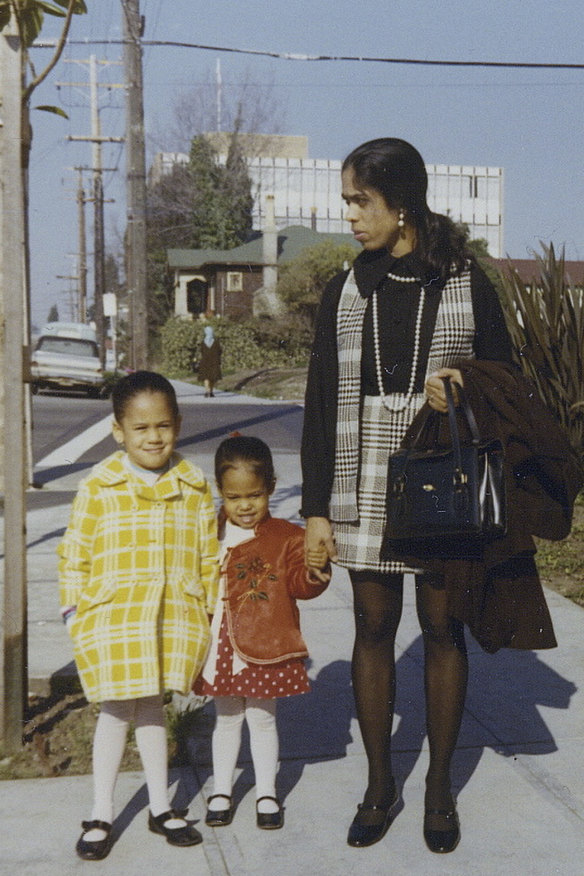
Kamala Harris in 1970 with sister Maya (centre) and mum Shyamala, who separated from her father, Donald, when Harris was five.Credit: AP
As Harris started to eye public office, her personal life merged with the political. In 1994, she started dating Willie Brown, a flamboyant African-American Democratic powerbroker who was then serving as the speaker of the California state assembly. They became the talk of the town: the glamorous young prosecutor and the rascally showman pollie 30 years her elder, who had separated from his wife but not divorced her. The subtext was that Brown had become her political sugar daddy: the boyfriend who bought her a BMW and gave her plum posts on two state regulatory boards worth around $US80,000 a year.
Perhaps his most valuable gift was the entrée he gave her to the donor base of super-rich northern Californians, the financiers of political campaigns. “Willie Brown was one of the most powerful men in California politics ever,” says Ron Christie, who knew the Harris family as a child and served as one of the most senior black aides in George W. Bush’s White House. “He moulded her and groomed her.”
Harris and Brown broke up after he was elected mayor of San Francisco in 1995 – there was “no permanency in our relationship”, she said later – but he had given her a crucial leg up. They remain friends, even though Brown published an op-ed in the San Francisco Examiner in 2019 bemoaning of how she was unique among his protégés: “the only one, who, after I helped her, sent word that I would be indicted if I ‘so much as jaywalked’ while she was D.A. That’s politics for ya.” Maybe her threat was to assert independence from a domineering politician who once punished a California legislator who failed to back him in a key vote by ordering the removal of all the furniture from his parliamentary office. “I think she got her toughness from him,” says Ron Christie.
Her first political campaign, where she sought election as the city’s district attorney, established her reputation as a brawler. Not only did the then 38-year-old take on her former boss, Terence Hallinan. She lambasted him as “soft on crime”, and made it clear she wouldn’t hesitate to prosecute him for corruption if a case arose.
This brutal race showed how flawed is the stereotypical view of San Francisco Democrats as super-woke liberals too broad-minded – to borrow from the poet Robert Frost – to take their own side in a quarrel. Rather, the city has provided the nursery for some of America’s most hard-nosed politicians: the Democratic House Speaker Nancy Pelosi, the 87-year-old California Senator Dianne Feinstein and the state’s high-flying governor, Gavin Newsom, Harris’s potential rival for the presidency. “One of the reasons that San Francisco politicians have done so well is that they are so practical and pragmatic,” says Louise Renne. “They’re not all kooky liberals.” Ron Christie, a Republican, agrees: “There’s a veneer of civility and gentility in San Francisco politics, but it’s brass-knuckles stuff. She exemplifies that.”
Kamala Harris brought to her new job a belief in the majesty of the law – on foreign trips, she makes a point of visiting the supreme court building of that country – and also an insider’s knowledge of the failings of the criminal justice system. In an approach reminiscent of Tony Blair’s famed Third Way dictum, “tough on crime, tough on the causes of crime,” she sought to strike that same balance.
“There’s a veneer of civility and gentility in San Francisco politics, but it’s brass-knuckles stuff.”
But the racially charged politics of law enforcement made it harder to chart a middle course. This she was reminded of in 2004, when she refused to pursue the death penalty against a gang member who murdered a San Francisco cop. When her fellow Democrat Dianne Feinstein criticised the decision at the officer’s funeral, hundreds of police officers rose to applaud.
More often, however, Harris came under fire from the left of her party. When San Francisco’s conviction rate jumped from 52 to 67 per cent between 2003 and 2006, critics labelled her a mass incarceration prosecutor, a zealous and ambitious jailer.
It is testament to her astuteness as a politician that she not only remained viable, but continued on an upward trajectory. But, then, as her Indian-born mother told the Los Angeles Times in 2004: “A culture that worships goddesses produces strong women.” That year, Harris won election as California’s attorney general, becoming the first woman to occupy a statewide office that made her one of America’s most powerful legal figures.
“If a stand needs to be taken, she will take a stand.”
Her priority was to punish Wall Street for its recklessness ahead of the subprime mortgage crisis, the financial meltdown that precipitated the 2008 global financial crisis. For months, the big banks had been negotiating a settlement with the states, which California was expected to sign. Yet despite being strong-armed by the Obama White House, Harris refused to add her signature. Only after a heated exchange with the country’s best-known banker, JPMorgan Chase chairman Jamie Dimon, was the standoff resolved.
“You’re trying to steal from my shareholders,” he yelled, when Harris bypassed his battalion of corporate attorneys to telephone him directly. “Your shareholders?” she replied in exasperation. “My shareholders are the homeowners of California.” Two weeks later, the banks agreed to a settlement of about $US25 billion, with California receiving four times the original offer in mortgage relief. “If a stand needs to be taken,” says Louise Renne, “she will take a stand.”
By then, Harris had come to the nation’s attention, though not in the manner in which she would have liked. At a Democratic fundraiser in 2013, Barack Obama waxed too lyrical in complimenting his longtime friend, the first prominent Californian Democrat to back him rather than Hillary Clinton when he sought the presidency. “She is brilliant and she is dedicated and she is tough,” he said, adding, “She also happens to be, by far, the best-looking attorney general in the country.”
Perhaps picking up on the uneasy laughter in the room, Obama added: “It’s true! C’mon.” Guilty of such blatant everyday sexism, Obama called her later to apologise. Afterwards, Harris helped him contain the political fallout. Her office issued a statement stressing the two were old friends and had a “great conversation”.
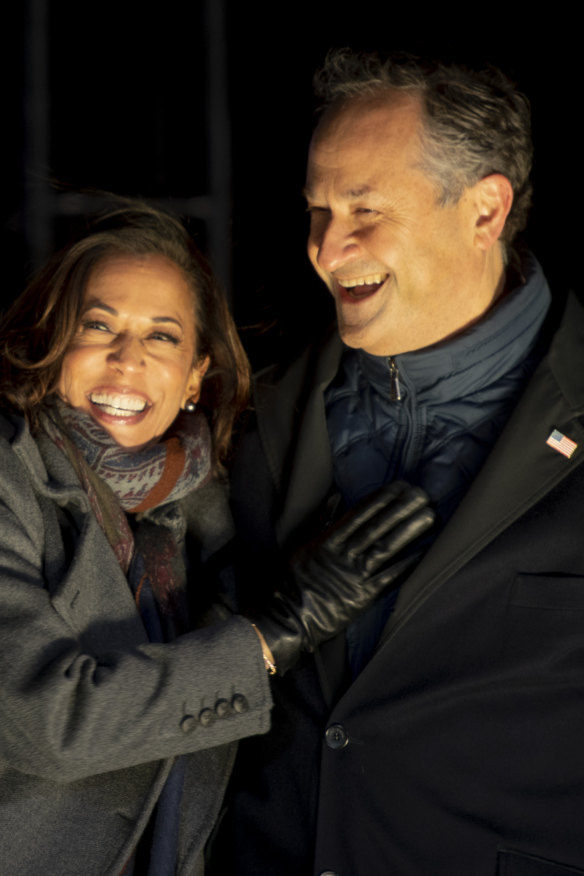
Kamala Harris on the campaign trail with lawyer husband Doug Emhoff, whom she met on a blind date.Credit: Getty Images
That year, Harris had started dating a new boyfriend, the managing partner of a Los Angeles law firm whom her best friend wanted her to meet on a blind date. Doug Emhoff first made contact by text, then left a rambling and almost adolescent voice message that he immediately regretted. Despite this initial awkwardness, their first meeting went well. “I’m too old to play games or hide the ball,” wrote Emhoff, a Hollywood entertainment lawyer, in an email the next morning. “I really like you, and I want to see if we can make this work?”
In that transactional manner in which American attorneys are prone to interact, they decided to commit to each other for six months. They were married the following year, in a ceremony blending her Indian heritage and his Jewish faith. She became the stepmother to Emhoff’s two grown-up children, Cole and Ella, from his first wife. They call her “Momala”, and have described the couple as “vomit-inducingly cute”.
Only months into their marriage, news broke that would take her from the West Coast to the East. California’s veteran Democratic senator, Barbara Boxer, announced her retirement after almost a quarter-century on Capitol Hill. Seizing upon a rare opening, Harris declared her candidacy for the vacancy the following week. With the endorsement of Obama, she won with more than 60 per cent of the vote.
Her victory came on the night in 2016 that Donald Trump unexpectedly beat Hillary Clinton. This crowning moment of her political career came with the emotional hangover of Donald Trump’s election to the White House. Rather than partying with her campaign team, she retreated to the couch with her husband and ate an entire family-size bag of Doritos.
Two months later, after being sworn in by the then vice-president Joe Biden, Harris delivered her maiden Senate speech. “For me, it starts with my mother,” she said of becoming only the second black female senator in history. Alas, Gopalan, who had died from cancer seven years earlier, wasn’t there to see that day.
Of all the Democrats to announce for the presidency in 2019 – a list that included Biden, Bernie Sanders and Elizabeth Warren – Harris had by far the most impressive rollout. More than 20,000 supporters attended an outdoor rally in Oakland, close to the hospital where she was born and the courtroom where she argued her first case. Her speech, a retelling of her story of immigrant success, was standard “American dream” fare. But in a country that will have a non-white majority in less than 25 years’ time, she seemed to personify not just the dream but the American future – certainly more so than her septuagenarian rivals.
The event may not have generated quite the same excitement as Springfield, Illinois, in 2007, when Barack Obama announced his candidacy on the steps of the Old State Capitol where Abraham Lincoln had delivered his “House Divided” speech, but she managed to pull a larger crowd. Over the next 24 hours, she also matched the record set by Bernie Sanders for the most money raised after a campaign launch, an impressive show of strength.
Prior to mounting her run, Harris had already built a reputation as one of Washington’s rock star lawmakers, best known for the prosecutorial rigour she brought to committee hearings. Trump administration officials, such as the former Homeland Security secretary John Kelly (who later became Trump’s White House chief of staff) and the then attorney general Jeff Sessions were treated like perps. “I’m not able to be rushed this fast!” complained Sessions during one particularly uncomfortable grilling. “It makes me nervous.”
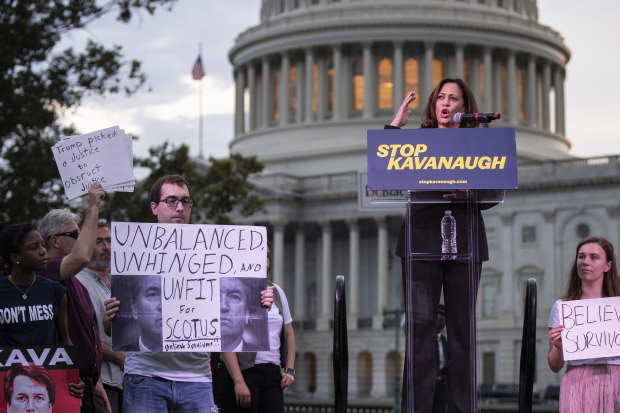
Rallying against Supreme Court nominee Brett Kavanaugh in 2018. Kamala Harris’s Senate questioning of him was called “nasty” by then President Trump. Credit: Getty Images
Her cross-examination of Trump’s second nominee for the Supreme Court, Brett Kavanaugh – who faced allegations of sexual assault from his years at an elite private school – became one of the pass-the-popcorn moments of these blockbuster hearings. “Can you think of any laws that give the government the power to make decisions about the male body?” she asked of Kavanaugh, a pro-life conservative opposed to Roe v Wade. Glued to his flat-screen television, Donald Trump was appalled. “She was extraordinarily nasty,” he complained. “She was nasty to a level that was just a horrible thing.”
Her presidential run came with the publication of her memoir, The Truths We Hold, which felt like an attempt to mirror Obama’s bestselling Dreams from My Father. And there were obvious parallels. Both were products of mixed-race relationships forged on American campuses during the tumultuous ’60s. Both spent formative years in foreign lands: Indonesia for Obama, Francophone Canada for Harris (she spent her teenage years in Montreal, where Shyamala had taken up a post at the prestigious McGill University). Both had sisters called Maya. Both had indomitable mothers and absent fathers.
Yet whereas Obama had been fixated with his father, Donald Harris barely received a mention. Clearly, their relationship is strained. In 2019, Professor Harris, who had ended his teaching career at Stanford University, even mounted a scathing attack on his daughter after she jokingly admitted to smoking pot. “Half my family’s from Jamaica,” she had laughed. “Are you kidding me?” Her father was incensed. “My deceased parents must be turning in their grave right now to see their family’s name, reputation and proud Jamaican identity being connected, in any way, jokingly or not, with the fraudulent stereotype of a pot-smoking joy seeker and in the pursuit of identity politics,” he harrumphed on a website. “That was a real smackdown,” says Ron Christie, whose father was a close friend of Donald Harris.
Her autobiography was also an attempt to reframe her years in the criminal justice system, and to recast herself as a “progressive prosecutor”. She used the phrase repeatedly to inoculate herself against the charge that she was too aggressive. To critics, however, this attempt to balance punishment and protection reeked of triangulation, and came at a time when triangulators, such as Bill and Hillary Clinton, were seen as cynical centrists.
Just as her book failed to scale the same literary heights as Obama’s – she did not subject herself to the same self-interrogation – her poll numbers fizzled. When the Democratic candidates met for their first debate in June 2019, however, she engineered the kind of viral showdown that momentarily upended the race. Desperate for a breakout moment, she mounted an attack on the frontrunner Joe Biden, upbraiding him for his cordial relationship with segregationist senators early in his career on Capitol Hill and his opposition to busing. “There was a little girl in California who was part of the second class to integrate her public schools,” she said, with the theatricality of a prosecutor building up to the killer line of argument, “and that little girl was me.”
Afterwards, Harris became a darling once more of the punditocracy on CNN and MSNBC; after all, cable news has built an entire business model on contrived confrontation. Yet she stumbled as a frontrunner. Her campaign lacked a galvanising theme. Her stump speech sounded like political muzak, background noise that never cut through. With black voters gravitating towards Biden, Obama’s loyal deputy, she did not have a base. Moderates looking for a generational shift preferred Pete Buttigieg, a fresh-faced former mayor in his late 30s seeking to become the country’s first openly gay president. There was something two-dimensional about her candidacy, and soon she was tagged with that lethal campaign cliché: not yet ready for prime time.
Bleeding money and with her campaign beset by factionalism – her sister, Maya, who in 2016 had served as a senior adviser to Hillary Clinton, proved an ineffective campaign chair – she withdrew from the race in December 2019 before even a single vote had been cast. “The spectacular collapse of Kamala Harris”, was how Politico headlined its post-mortem. “The moment – and the stage – proved too large,” it concluded.
Then, though, she became the favourite in the VP stakes. With Biden expected to become the presidential nominee, the Democratic ticket needed a woman and, after the Black Lives Matter summer, a person of colour. So it came as no surprise when he picked her as his running mate, having written off her “that little girl was me” attack as a routine professional political hit. In mending fences, it also helped that Harris had been a friend of Biden’s late son, Beau, the former attorney general of Delaware and an ally during the battle with the banks.
“You ready to go to work?” asked Biden, peering somewhat quizzically into his laptop on the day he announced his pick. “Oh my god,” replied Kamala Harris, as if reacting to a proposal of marriage. “I’m so ready to go to work.”
Now she arrives dressed in the colour purple, that politically symbolic blend of the red and the blue, and waits for a moment as Joe Biden levers himself out of his bomb-proof limousine. It is January 20, 2021. Inauguration Day. We are in the final minutes of the Trump presidency.
Together with their partners, America’s incoming power couple climbs the steps of the US Capitol flanked by an honour guard of police officers who only two weeks earlier had been overrun on this very spot by an insurrectionary pro-Trump mob. Harris was in the Senate that sorry day, and had to be evacuated, along with colleagues, to an underground bunker. Because of the threat of further violence, Washington looks like it is under military occupation: Baghdad on the Potomac. Troops are on the streets to prevent American from attacking American.
Military trumpeters are also on hand, who blast out a fanfare to herald her entry onto the inaugural stand. From the press riser, I watch her mask-kiss her young niece, and joyfully fist-bump Barack and Michelle Obama. “So proud of you,” he mouths. Then she hugs her husband, who is about to become the country’s first Second Gentleman. After Lady Gaga has delivered an electrifying rendition of The Star-Spangled Banner, Harris steps forward to take her oath of office, which is administered by Justice Sonia Sotomayor, America’s first Latina Supreme Court justice.
Understandably, she gets irritated by being called the female Obama … she wants to be judged on her own merits, accomplishments and life story.
Harris removes her mask, places her hand on the Bible of Thurgood Marshall, and finds it impossible to suppress her trademark smile as she delivers the final words, “So help me God.” Then she fist-bumps Joe Biden, before retaking her seat to watch his swearing in. In that historic instant, as the marine band strikes up Hail to the Chief, she has not only become Biden’s heir apparent, but maybe Obama’s, too.
Understandably, she gets irritated by being called the female Obama, for the obvious reason she wants to be judged on her own merits, accomplishments and life story. But it is also debatable whether she warrants that mantle. Obama became the poet laureate of his own story, while Harris does not have that same oratorical gift. Obama’s rise often seemed effortless and preordained, whereas she has toiled hard. America’s first black president presented himself as a visionary, who raised hopes of a post-racial and post-partisan nation. Few Americans speak any longer with such optimism. Obama seemed to be a once-in-a-lifetime figure. Even her admirers in the Democratic Party do not speak of her in such exceptional terms.
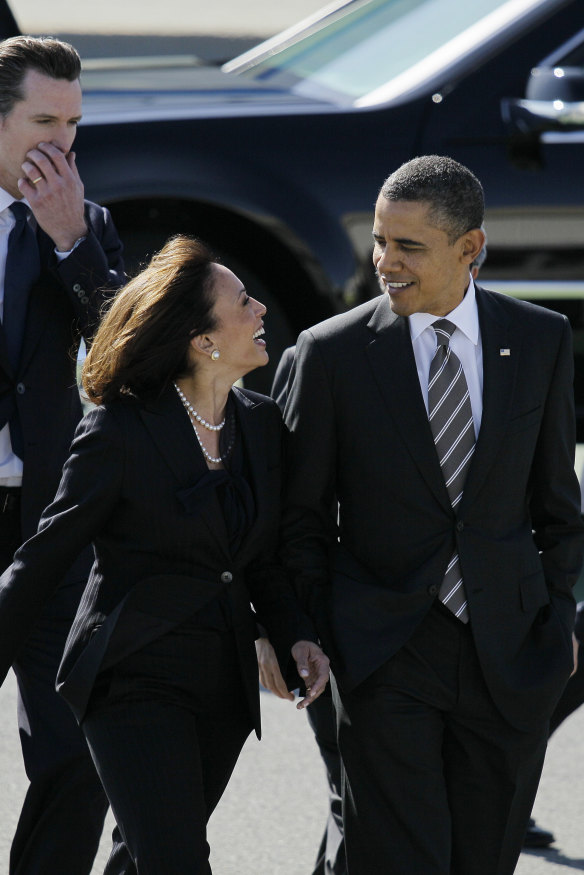
With her friend Barack Obama.Credit: AP
Here, though, she suffers from being a post-Obama figure. Had he not become the first African-American to occupy a White House built by slaves, a Harris presidency might have seemed more thrilling to Democratic primary voters. And paradoxically, his realisation of that historic racial first has placed obstacles in her path. Under Obama, the US became more polarised and racialised, paving the way for the rise of a white nationalist in Donald Trump. With Kamala Harris, misogyny as well as racism would be thrown into America’s toxic brew: misogynoir is the term that describes the unique discrimination against black woman.
Few Democrats doubt Harris has the qualifications and smarts to take over from Joe Biden if he is unable to finish his term. The more arguable question is whether she could run for the presidency and win, if, as many expect, Biden retires at the end of four years. It is by no means certain she would even secure the Democratic presidential nomination, given her faltering performance last time around.
Under Obama, the US became more polarised and racialised, paving the way for the rise of a white nationalist in Donald Trump.
The kind of challenges she would encounter surfaced in her televised debate with then vice-president Mike Pence last October, when much of the reaction afterwards revived the old racist trope of the “angry black woman”. Donald Trump twice called her “a monster” and “totally unlikeable”. Old prejudices die hard, and senior Democrats worry about her electability, that prejudicial code word often attached to female candidates.
The recent flap over the cover of US Vogue – a portrait of her in Converse sneakers and jeans rather than the shot in a business suit with a flag pin that her team thought more fitting – showed how women are treated differently, even by supportive publications. Cover portraits of male politicians tend to be styled in a way that accentuates their power. Vogue’s decision to dress her down implied she did not exude the same authority. “Post-Barack Obama and post-Hillary, the United States is not post-racial or post-gender,” says Debbie Walsh, the director of the Centre for American Women and Politics at Rutgers University, “so there are clearly still issues. But she has faced a lot of these racist and sexist tropes in the past, and I don’t think these challenges are prohibitive.”
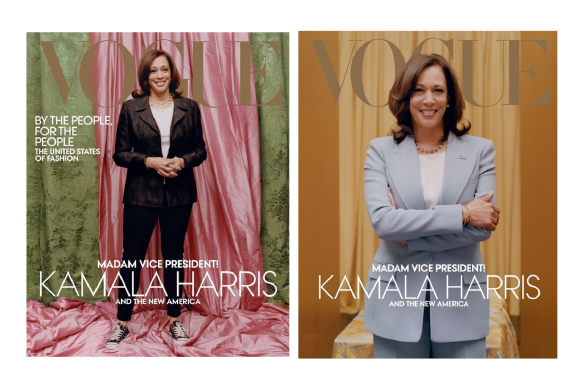
US Vogue was criticised for the dressed-down cover shot (at left), rather than the more styled one (right) which accentuates power.Credit:
In assessing her political prospects, I’m constantly struck by the discrepancy between how Kamala Harris is viewed internationally and at home. Beyond US shores, there seems to be more buzz around her vice-presidency. It’s almost as if the rest of world is yearning for an Obama-like figure to restore its faith in the US. People here have a keener sense of the chronic state of disunion, and fear that the presidency of a black woman could unleash an even uglier “white-lash”.
What does history teach us? Of the 14 US presidents since the early 1940s, six have served as vice-president. Harry Truman, Lyndon Johnson and Gerald Ford took over midway through their successors’ terms (the first two were then elected in their own right). Richard Nixon, George Herbert Walker Bush and Joe Biden, of course, were elected to the White House. But it’s also worth remembering that three of the vice-presidents who became the Democratic nominee – Hubert Humphrey, Walter Mondale and Al Gore – fell short. Nixon also failed in his first attempt in 1960, when he was Dwight D. Eisenhower’s deputy.
Joe Biden has not yet given Harris any specific policy portfolio, indicating she will be involved in all the major work of his administration. And much of her time could be spent on Capitol Hill. With the upper chamber split 50-50 between Democrat and Republican caucuses, she has the casting vote in her dual constitutional role as the president of the Senate. Certainly, she will become one of the most prominent members of the Biden administration, a team comprised largely of technocrats short on political star power and journalistic entertainment value.
Sometimes it is said of those who reach the pinnacle of American power that they don’t choose the time but rather the time chooses them. That has been especially true of vice-presidents, like Lyndon Johnson and Gerald Ford, who inherited the presidency in unexpected ways. So will that come to be said of Kamala Devi Harris? What does fate have in store for her? As we watched the swearing in of America’s 46th president, the pregnant question on so many lips was: were we also in the presence of the 47th?
To read more from Good Weekend magazine, visit our page at The Sydney Morning Herald, The Age and Brisbane Times.